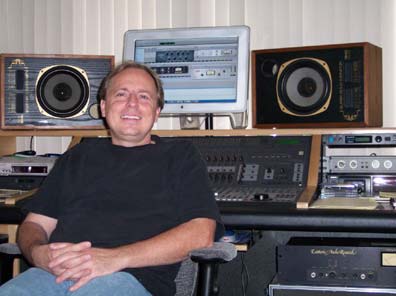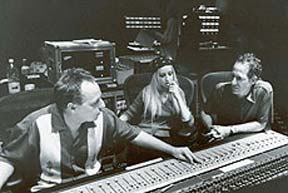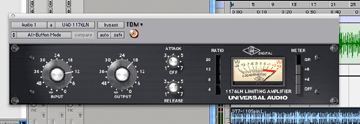Digital Discourse: Michael Ross Makes the Switch From Analog to Digital
Digital Discourse replaces the UAD-1 Feature and remains one of two excellent interview columns by Marsha Vdovin the Media Maven; the other being Analog Dialog. In addition to UAD-1 users, Digital Discourse now encompasses interviews with those using any UA digital product.
 |
|
Michael Ross in his studio
|
Some veteran recording engineers find it difficult to make the move from analog to digital recording. Not so for Michael Ross. A long time fixture in L.A.’s top studio control rooms, Ross is happy to be working digitally with Universal Audio’s TDM Compressor bundle—digital emulations of UA’s vintage hardware for use with Digidesign Pro Tools.
Ross came to L.A. as a teenage drummer with a gospel group. They made a record and once he saw the process he was hooked. Moving to L.A. and working his way here and there he landed a job as assistant engineer at Weddington Studio (now NRG Studios).
It must be hard to choose a favorite studio in a city like LA where there are so many world-class facilities. When pressed, Ross says that Ocean Way is probably his favorite because he worked there for so many years. He recorded and mixed the Grammy-nominated debut album by Vanessa Carlton at Henson Sound (formerly A & M) “which is a great place”, said Ross. But Ross has a real attachment to Ocean Way (designed by Bill Putnam). “Perhaps it’s because I worked there for so long and I know it so well. I really learned a lot there. I had the opportunity to see so many records take shape. It was an incredibly valuable experience.”
“One of the last records that I worked on while I was on staff at Ocean Way was Elvis Costello’s Spike album in 1989. It was an amazing process. T-Bone Burnett was co-producing with Elvis and Kevin Killen. Kevin also engineered. For this record, Elvis had co-written several songs with Paul McCartney. We did all the recording at Ocean Way except for the bass on the songs Paul McCartney co-wrote.”
“It was the first record I ever worked on where the bass was recorded last. They took the music to England to record Paul McCartney’s parts and then they were going to mix it there but they called me up and said, ‘Mike, we can’t beat the rough mixes from Ocean Way. So we’re coming back. We have to mix in Studio 2 at Ocean Way. Make sure we can have it on these dates.’ (Studio 2 is now part of Cello Studios)
 |
|
Michael C. Ross, Christina Aguilera and Producer Ron Fair
|
So I got to be involved in the mix; it was one of the last records that I mixed on the Neve 8028 (which is still in Studio 2) before they put in automation. They liked the sound of the board so much that I got to help Kevin mix the record 8 bars at a time. We’d mix eight bars, then cut it into the next section, mix the intro, put it onto half inch, mix the first verse put it on half inch. Do a few versions cut the best version together, do the chorus…”
“It was very fun. Working with automation is great but you get a certain excitement when you do it all live. Accidents happen and then someone says ‘wait, what was that, I liked that.’ I have a lot of fond memories of working at Ocean Way. That was 1989, and it was the first gold record I ever got.”
Working at Ocean Way also gave Ross the advantage of working with equipment, specifically UA hardware, which was well maintained. “One of the nice things about working at Ocean Way (and at Schnee Studio prior to that), is that they always had LA-2As in very good condition. That helped me when I worked in other studios because I would know when something was wrong with the LA-2A. I used to send everyone to my friend Steve Haselton (chief tech at Mastering Lab) to have them serviced. Many of the studios wouldn’t realize that a tube was bad. To me it’s very clear when something is off, because I know the sound of the pristine units at Ocean Way and Schnee’s.”
 |
|
UA TDM 1176 in “All-Button Mode”
|
These days Ross is content with the UA TDM Compressor plug in bundle. “With the software, you know exactly what you are going to get. I love to use the 1176 for the ‘broken’ setting. When you press in all four compressor buttons, it makes the 1176 pump and the compressor doesn’t like it. Someone from Universal Audio showed me how to do it on the TDM plug in and it works! I tried it on other brands of 1176 plug ins and it didn’t sound right. UA has the real thing.” (this is also called ‘All-Button Mode’ or ‘British Mode’ – more info about this is available in the
April '03 Compression Obsession column)
“It’s definitely my secret weapon. I feed drums into it. It adds attack to drums and then I mix it back in. You just have to mess with the attack and release time and really get the compressor to pump. It works great on all drums, you can put the whole drum kit thru it or just kick and snare and then mix them back in. It really helps drums sound better.”
I wondered with so much experience, was it possible to have a defining project that he was most proud of? After a long pause, Ross answered.
“That’s hard, but I guess it would have to be Vanessa Carlton’s debut album. Before it was released I knew it was special. I told a bunch of people, ‘I’ll see you at the Grammys!’ I knew there was something special about it. It’s an exceptional record. It was another great experience. I’ve worked with Producer Ron Fair for a long time and it was nice to be nominated for a Grammy with him. I’m very proud of that record.”
-Marsha Vdovin
Questions or comments on this article?


